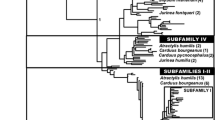Summary
A new type of repeat unit was isolated from Balbiani ring 1 ofChironomus pallidivittatus and designated, BR1β repeat. It consists of a constant and a subrepeated part, like previously described units belonging to the core blocks of the BR genes. The subrepeated part contains 10-codon subrepeats with an arrangement similar to the subrepeats of the previously described BR2β gene. The present unit differs from earlier reported core units firstly in a much lower number of copies (about 15) per genome, which are tandemly arranged. Secondly, the number of subrepeats per BR1β repeat unit can show great variations. On the basis of the pattern of codon usage, three types of subrepeats can be distinguished. One type lies 5′-proximal in the subrepeat array and consists of variable numbers of subrepeats almost identical at the nucleotide level. The last complete subrepeat represents another type, with consistent differences in codon usage as compared to subrepeats of the proximal type. Finally, there is an intermediate type represented by the subrepeat preceding the distal one. Here, codon characteristics from proximal and distal subrepeats are mixed in a patchy and irregular way. The evolution of the arrays can be understood either as being the result of subrepeat formation in two steps (occurring before and after amplification of whole repeat units) or as the result of a continuous process in which there is evidence for participation of gene conversion.
Similar content being viewed by others
References
Bäumlein H, Wobus U, Gerbi S, Kafatos FC (1982) Characterization of a 249-bp tandemly repetitive, satellite-like repeat in the translated portion of Balbiani ring c ofChironomus thummi. EMBO J 1:641–647
Beermann W (1955) Cytologische Analyse eines Campto-chironomus-Artbastards. I. Kreuzungsergebnisse und die Evolution des Karyotypus. Chromosoma 7:198–259
Case ST (1986) Correlated changes in steady-state levels of Balbiani ring mRNAs and secretory polypeptides in salivary glands ofChironomus tentans. Chromosoma 94:483–491
Case ST, Daneholt B (1978) The size of the transcription unit in Balbiani ring 2 ofChironomus tentans as derived from analysis of the primary transcript and 75S RNA. J Mol Biol 124:223–241
Case ST, Summers RL, Jones AG (1983) A variant tandemly repeated nucleotide sequence in Balbiani ring 2 ofChironomus tentans Cell 33:555–562
Daneholt B, Edström J-E (1967) The content of deoxyribonucleic acid in individual polytene chromosomes ofChironomus tentans. Cytogenetics 6:350–356
Galler R, Rydlander L, Riedel N, Kluding H, Edström J-E (1984) Balbiani ring induction in phosphate metabolism. Proc Natl Acad Sci USA 81:1448–1452
Galler R, Saiga H, Widmer RM, Lezzi M, Edström J-E (1985) Two genes in Balbiani ring 2 with metabolically different 75S transcripts. EMBO J 4:2977–2982
Grond C, Saiga H, Edström J-E (1987) The sp-I genes in the Balbiani rings ofChironomus salivary glands. In: Hennig W (ed) Structure and function of eukaryotic chromosomes. Results and problems in cell differentiation, vol 14. Springer-Verlag, Berlin, pp 69–80
Jäckle H, de Almeida JC, Galler R, Kluding H, Lehrach H, Edström J-E (1982) Constant and variable parts in the Balbiani ring 2 repeat unit and the translation termination region. EMBO J 1:883–888
Kafatos FC, Jones CW, Efstratiadis A (1979) Determination of nucleic acid sequence homologies and relative concentrations by a dot hybridization procedure. Nucleic Acids Res 7: 1541–1552
Langer-Safer PR, Levine M, Ward DC (1982) Immunological method for mapping genes onDrosophila polytene chromosomes. Proc Natl Acad Sci USA 79:4381–4385
Lendahl U, Wieslander L (1985) Abrupt evolutionary change in the Balbiani ring gene family in two sibling species ofChironomus. J Mol Evol 22:63–68
Lendahl U, Saiga H, Höög C, Edström J-E, Wieslander L (1987) Rapid and concerted evolution of repeat units in a Balbiani ring gene. Genetics 117:43–49
Maxam AM, Gilbert W (1980) Sequencing end-labelled DNA with base-specific chemical cleavages. Methods Enzymol. 65: 499–559
Pustell J, Kafatos FC, Wobus U, Bäumlein H (1984) Balbiani ring DNA: sequence comparisons and evolutionary history of a family of hierarchically repetitive protein-coding genes. J Mol Evol 20:281–295
Rydlander L, Pigon A, Edström J-E (1980) Sequences translated by Balbiani ring 75S RNA in vitro are present in giant secretory protein fromChironomus tentans. Chromosoma 81:101–113
Saiga H, Edström J-E (1985) Long tandem arrays of complex repeat units inChironomus telomeres. EMBO J 4:799–804
Saiga H, Grond C, Schmidt ER, Edström J-E (1987) Evolutionary conservation of the 3′ ends of members of a family of giant secretory protein genes inChironomus pallidivittatus. J Mol Evol 25:20–28
Smith GP (1976) Evolution of repeated DNA sequence by unequal crossover. Science 191:528–535
Sümegi J, Wieslander L, Daneholt B (1982) A hierarchic arrangement of the repetitive sequences in the Balbiani ring 2 gene ofChironomus tentans. Cell 30:579–587
Wieslander L, Sümegi J, Daneholt B (1982) Evidence for a common ancestor sequence for the Balbiani ring 1 and Balbiani ring 2 genes inChironomus tentans. Proc Natl Acad Sci USA 97:6956–6960
Wieslander L, Höög C, Höög J-O, Jörnvall H, Lendahl U, Daneholt B (1984) Conserved and non-conserved structures in the secretory proteins encoded in the Balbiani ring genes ofChironomus tentans. J Mol Evol 20:304–312
Author information
Authors and Affiliations
Rights and permissions
About this article
Cite this article
Saiga, H., Botella, L. & Edström, J.E. Subrepeats within the BR1β repeat unit inChironomus pallidivittatus can be classified into different types depending on codon usage. J Mol Evol 27, 298–302 (1988). https://doi.org/10.1007/BF02101191
Received:
Revised:
Issue Date:
DOI: https://doi.org/10.1007/BF02101191




